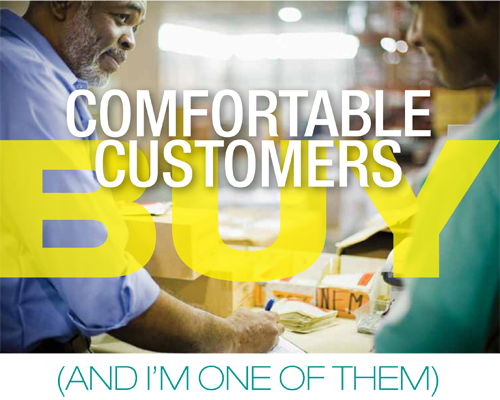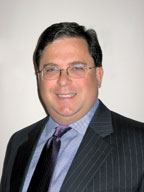Comfortable customers buy

By Troy Harrison
For years, I’ve been speaking, training and writing about how “Comfortable Customers Buy.” It’s even become a tag line for me. It’s something that I believe in; when we, as salespeople, put our customers in a comfortable mood, they are much more receptive to messages that help them make a beneficial buying decision. And yet, until recently, I never truly appreciated the truth of that statement.
To review, several weeks ago, I fractured my kneecap in a motorcycle accident. It was painful and a little scary, since I’ve never broken a bone, had surgery, or spent the night in a hospital before – yet I did all those things in about 20 hours. My injury happened in Iowa, and when I returned to Kansas City, I consulted with a local orthopedic specialist. And then, I did something you’re not supposed to do. I switched orthopedic specialists. My reasons why will fully explain why “comfortable customers buy.” (And uncomfortable ones don’t.)
When I arrived at the first orthopedic specialist, I filled out the volumes of forms, and then was greeted impersonally by a nurse who brought me back to the examination room. I then discovered that I was to see a Physician’s Assistant, rather than a doctor. Well, OK, maybe that’s how this goes. They gave me X-rays, the PA discussed the X-rays with a doctor that I never met, and basically told me that any ideas of rehabilitation would be out of the question until our next appointment three weeks hence. Sit around until then – that was the prescription.
I was dubious, but I decided to stick with them. As the appointment approached, however, they called me to reschedule the appointment. Eventually they rescheduled three times, and I told them to forget it. I found a different firm, and received a completely different experience.
At the second firm, I was greeted by a nurse who asked me a few questions about my injury (the first firm had not asked me any questions), and then took me to see a surgeon. The surgeon examined the X-rays, showed me what they meant, and then asked me questions about my work, my lifestyle and my upcoming commitments. With those answers, he prescribed a rehabilitation protocol and gave me a preview of what the next three months would look like (including the admonition to stay off the motorcycle until December). It was specific, positive and personalized based on my own answers to him. To make a long story short, further visits to him and to his referred rehabilitation specialist have been positive and productive.
I’m now a comfortable customer. And I’m buying what the surgeon is selling. Why? What he did could suggest some principles of “Comfortable Customers Buy.”
They made me feel at home. From the beginning, both the nurse and the surgeon made it clear that I was welcome there (even though I’d had surgery elsewhere), and I wasn’t just an afterthought. I’m now their patient, and they’re glad to have me. From the first moment the nurse greeted me, she made me feel right at home.
They communicated authority and expertise. When I’m worried about my physical condition, I want to see a doctor. And I saw one. I was talking to the expert, I knew it, and he knew it. Doctors can communicate expertise through a white coat – how can you do it?
They asked a lot of questions. I’ve said it before and I’ll say it until I can say it no more. Questions – GOOD questions, not leading questions – show that you care. How good were the questions? Well, here are some samples: “What do you do for a living? A speaker? OK, when is your next speaking engagement? Well, you’ll be able to stand and walk by then with a leg brace; will that be acceptable? Good.” The doctor, nurse, and even the X-ray tech made it clear that the experience was about ME, not them.
They told me what the road ahead looked like. From the moment that I found myself flat on my back on U.S. Highway 71 in Iowa, the scariest part for me was the unknown of the future. How long would it take for me to come back, to walk normally, to travel, to work, and yes, to ride again? My surgeon in Iowa gave me some ideas, but he was reluctant to come up with a full plan because my after-care would be done in Kansas City. The first ortho specialist didn’t do anything to alleviate my fears. My current doctor was very clear about showing me the game plan – good and bad.
They connected me with other resources that I would need. Finally, the second doctor connected me with an excellent physical rehab therapist. He even said, “We have multiple specialists that we can use, but I think this is the best fit for you – you’ll want something a little more aggressive.”
The bottom line is that the second doctor took ownership of my recovery process and showed that he cared. He took me from a feeling of extreme discomfort to being comfortable. Don’t get me wrong – it’s not moving as fast as I like – but that’s biology, not his issue.
Here’s my queston to you: How can you implement the principles above into your sales program? Think about the different actions that doctor No. 2 did, and let’s look at them in a sales context.
Make them feel at home. This is perhaps the most difficult thing to accomplish in the world of selling. The most powerful obstacle we face is the customer’s fear of the unknown – or worse, fear of the known. Much of the time, customers anticipate that we are going to attempt to manipulate, coerce, or otherwise maneuver them into making a bad deal for themselves. How can you make someone feel at home? One of the best ways is to simply personalize the introduction to the sales call itself.
Communicate authority and expertise. People want to deal with those who are expert in their field. For a doctor, slipping on a white coat suffices. For salespeople, it’s a little different. Communication of authority and expertise, for me, has always begun with the way salespeople dress. Yes, I know, that golf shirt is comfy – but you look like every other shlub out there. I’m still a fan of conventional business dress. Not only do you look different, but you will interact differently with people. “Look sharp and you’ll be sharp.” Next, since a white coat isn’t available, why not simply tell your customer why you are uniquely qualified to help them improve their condition? Tell them and show them, through explanation of your expertise and then the application of it. This, of course, requires you to be a student of your own business.
Ask a lot of questions. Asking good questions is the best way to show a customer that you truly care about him, and that you’re on his side. And by good questions, I don’t mean junk like, “If I show you something that you like, you’ll be interested in buying, right?” Leading questions destroy customer comfort and trust, and require the customer to put up his defenses. Instead, I’m talking about questions that dig deep and give a strong understanding of the result that the customer is looking for. How will the customer define a successful purchase?
Tell them what the road ahead looks like. Here, again, we’re getting into the fear of the unknown. Customers worry about your process, because they feel (sometimes accurately) that your sales process is designed to put them at a disadvantage. Instead, tell them the steps involved in a purchase, and how they benefit the customer. Your customer will appreciate the road map, they will get more comfortable, and will trust you.
Connect them with other resources they’ll need. Immediately post-purchase is an excellent time to help your customer find other resources (if necessary) to optimize the buying experience and improve his/her condition. Lazy salespeople don’t do this; winning salespeople do.
Yes, I know, this is more work than simply asking the rote questions, giving your canned presentation, shooting a price, and hoping for an order. However, it’s a lot more successful – and a lot more profitable.
 Troy Harrison is author of “Sell Like You Mean It!” and president of SalesForce Solutions, a sales training, consulting and recruiting firm. For booking training, consulting or to sign up for his weekly E-zine, call (913) 645-3603, e-mail TroyHarrison@SalesForceSolutions.net or visit www.SalesForceSolutions.net.
Troy Harrison is author of “Sell Like You Mean It!” and president of SalesForce Solutions, a sales training, consulting and recruiting firm. For booking training, consulting or to sign up for his weekly E-zine, call (913) 645-3603, e-mail TroyHarrison@SalesForceSolutions.net or visit www.SalesForceSolutions.net.
This article originally appeared in the Jan./Feb. 2014 issue of Industrial Supply magazine. Copyright 2014, Direct Business Media.












